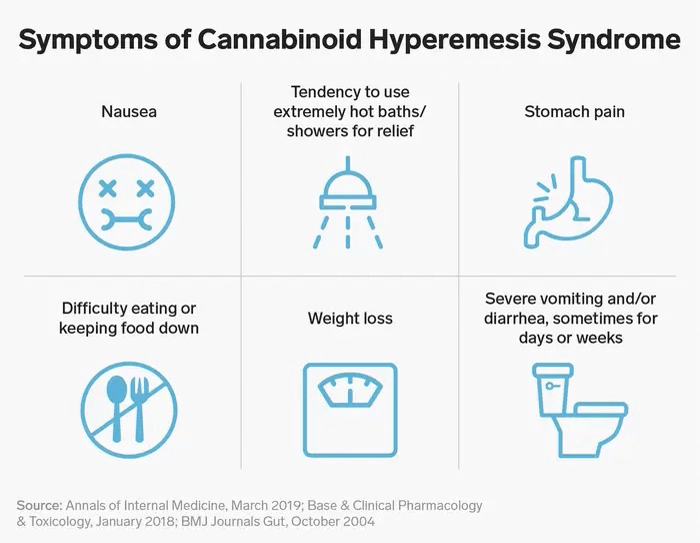No products in the cart.
Cannabinoid Hyperemesis Syndrome
3 Aug 2023

Cannabis is widely known for its potential medicinal benefits, including its ability to alleviate symptoms such as nausea and vomiting. However, there is a lesser-known condition with long-term cannabis use Cannabinoid Hyperemesis Syndrome (CHS). CHS is recurring episodes of intense nausea, vomiting, abdominal pain, and dehydration. In this article, we will delve into the causes, symptoms, diagnosis, treatment, and prevention of CHS to help you better understand this condition.
Understanding Cannabinoid Hyperemesis Syndrome
What is Cannabinoid Hyperemesis Syndrome?
Cannabinoid Hyperemesis Syndrome, is a condition that occurs in individuals who have been using cannabis for an extended period. It manifests as severe episodes of vomiting, nausea, abdominal pain, and dehydration. These symptoms can be debilitating and may require frequent visits to the emergency department for relief.

Who is at Risk of Developing CHS?
CHS is more likely to occur in individuals who chronically use cannabis, particularly those who have been using it since their adolescent years. It is estimated that up to 6% of people who visit the emergency room for vomiting may have CHS. However, due to the recent discovery of this condition, many cases may go unreported or misdiagnosed.
The Phases of CHS
CHS is characterized by three distinct phases: the prodromal phase, the hyperemetic phase, and the recovery phase.
- Prodromal Phase: This phase typically occurs in adults who have been using cannabis since their teenage years. Symptoms may include morning nausea, abdominal pain, and a fear of vomiting, although vomiting may not actually occur.
- Hyperemetic Phase: This phase carries intense and persistent nausea and vomiting, often occurring multiple times per hour. Individuals may also experience abdominal pain, weight loss, and dehydration. One unique aspect of this phase is the compulsive bathing or showering, which provides temporary relief from symptoms.
- Recovery Phase: During the recovery phase, individuals must completely abstain from cannabis use. Symptoms gradually lessen over a period of days to months, eventually disappearing entirely.
Causes and Symptoms of CHS
The Underlying Causes of CHS
The exact causes of Cannabinoid Hyperemesis Syndrome are not yet fully understood. However, researchers are proposing two potential mechanisms. Firstly, genetics may play a role in predisposing individuals to develop CHS. Secondly, the overstimulation of the endocannabinoid system (ECS) by long-term cannabis use is thought to contribute to the development of this condition.
Identifying the Symptoms of CHS
The primary symptoms of CHS include intense and persistent nausea, frequent vomiting, abdominal pain, weight loss, and dehydration. Individuals may also develop a compulsive need to take hot showers or baths, as this provides temporary relief from nausea. It is important to note that these symptoms may vary in severity among individuals.
Diagnosing and Managing CHS
Diagnosing CHS can be challenging, as there is no definitive test for this condition. Healthcare providers typically rely on a combination of symptoms and the patient’s history of cannabis use to make a diagnosis. It is crucial for individuals experiencing frequent vomiting to inform their healthcare provider about their cannabis use and provide details such as the frequency and duration of use.
Treating and Managing CHS
The only known cure for Cannabinoid Hyperemesis Syndrome is complete abstinence from cannabis use. It is important to note that symptoms may persist for a few weeks after quitting cannabis, but they will gradually disappear over time. In some cases, healthcare providers may recommend certain medications to alleviate symptoms temporarily. These may include antihistamines, antipsychotic medications, capsaicin cream for pain relief, intravenous hydration for severe dehydration, and pain relievers.
Prevention of CHS
The most effective way to prevent Cannabinoid Hyperemesis Syndrome is to avoid cannabis use altogether. If you or someone you know needs assistance with quitting cannabis, it is advisable to reach out to a primary care provider or local addiction treatment services. The Substance Abuse and Mental Health Services Administration (SAMHSA) National Helpline is also available for free, confidential, and 24/7 support.
The Outlook and Long-Term Effects of CHS
The Long-Term Effects of CHS
Research on the long-term effects of Cannabinoid Hyperemesis Syndrome is still ongoing. However, recurrent vomiting with CHS can lead to various health complications, including dehydration, esophagitis (inflammation of the esophagus), malnutrition, Mallory-Weiss syndrome (tears in the esophagus), and tooth decay. It is crucial to seek medical attention if CHS symptoms persist or worsen.
Living with Cannabinoid Hyperemesis Syndrome: When to Seek Emergency Care
Cannabinoid Hyperemesis Syndrome can increase the risk of severe dehydration, which requires immediate medical attention. If you experience symptoms such as dark or less urine output, delirium, dizziness, fatigue, rapid heart rate, rapid breathing, or fainting, it is essential to call 911 or go to the nearest emergency center.
In conclusion, Cannabinoid Hyperemesis Syndrome is a condition that can occur in individuals who have been using cannabis long-term. By recurring episodes of intense nausea, vomiting, abdominal pain, and dehydration. The only known cure for CHS is complete abstinence from cannabis use. If you suspect that you or someone you know may have CHS, it is important to consult a healthcare provider for an accurate diagnosis and appropriate management.






